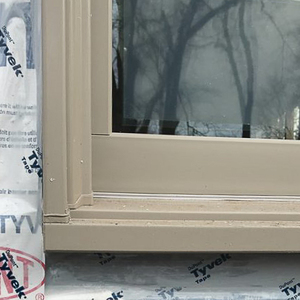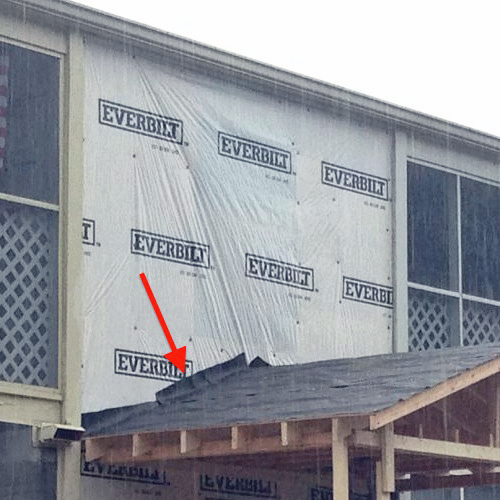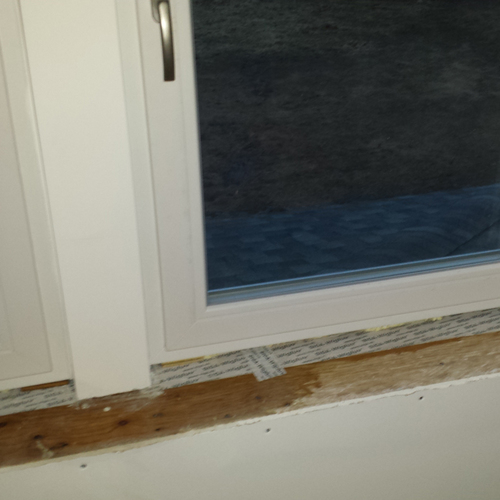Image Credit: Image #1: Kristof Irwin
Image Credit: Image #1: Kristof Irwin Installing windows before housewrap, as the builder of this home did, will probably lead to moisture problems. Notice that, unlike the window flashing details in the Hammer & Hand Best Practices Manual, the windows here had no moisture management before the housewrap went on.
Image Credit: Mike Guinan Window flashing details with housewrap. Notice the house comes down over the top of the flashing tape at the top of the window. The shingling of materials here reduces the likelihood of water intrusion.
Image Credit: Energy Vanguard
I see a lot of interesting stuff at construction sites and in people’s homes. I also see stuff I never got to see because people send me photos. I like photos! Remember that
ice chest someone had incorporated into a duct system? That was sent to me. So are the first two photos in this article.
The first one (right) is from my friend Kristof Irwin in Austin. He snapped this pic at a home under construction because it so clearly illustrates a lesson that all builders have to learn: how to do things in the right order.
See anything missing there? Oops! They started installing the siding before the windows were in. Even worse, they didn’t leave enough space to install the windows there. I actually got to see this house a few weeks later, and they’d had to go in and cut the siding back around the whole opening to make it work.
They may actually have done a decent job with the flashing details to keep water out, but they sure made things hard for themselves by not installing the windows before the siding.
The second photo (below) shows the opposite side of the same problem. Instead of waiting too late to install the windows, they installed them too early. Then someone realized they’d forgotten to install their main liquid water control layer, the drainage plane. (Well, we can hope they didn’t think of the housewrap as a vapor barrier, can’t we?)
So they just ran the housewrap over the windows as if they were doing it normally. I imagine they came back and cut the housewrap around the windows and then taped it all up from the outside.
The problem with just taping it from the outside is that you’re relying on two things: (i) The tape will be installed properly and last a long time, and (ii) no water will get behind the housewrap.
Tape can and does last, when you use the correct type and install it properly. But water has a tendency to get into all kinds of places it shouldn’t oughta go. If you don’t shingle the materials so that they shed water away from materials that are susceptible to moisture damage, you make it more likely that water will get in. Installing the housewrap after the windows means that it’s impossible to shingle it properly.
The last photo (below) shows what you want your housewrap to do around windows. Notice that the housewrap comes over the flashing tape at the top of the window. The tape is good, but with the housewrap coming over the top like that, the chances of water getting in are greatly reduced. The Hammer & Hand Best Practices Manual I wrote about recently has great details on how to do this.
One of the biggest lessons I learned when I was building a house was how important it is to do things in the right order. At best, you get lucky and it doesn’t matter. Sometimes, it means extra work but you can still end up where you want to be. Other times, it can spell trouble for the future because of the compromises made.
The builder of the home in that second photo certainly didn’t want to pull all those windows out and then install the housewrap to be able to get the flashing details right. But that’s really the only option there if they want to prevent the future homeowners from having to deal with the moisture problems caused by the mistake.
As painters in the 1930s found out, insulated buildings don’t dry out so well. When water gets in, it stays in and wreaks more mischief. Doing things in the right order and understanding moisture management is not optional anymore.
Allison Bailes of Decatur, Georgia, is a speaker, writer, energy consultant, RESNET-certified trainer, and the author of the Energy Vanguard Blog. Check out his in-depth course, Mastering Building Science at Heatspring Learning Institute, and follow him on Twitter at @EnergyVanguard.
Weekly Newsletter
Get building science and energy efficiency advice, plus special offers, in your inbox.
















0 Comments
Log in or create an account to post a comment.
Sign up Log in